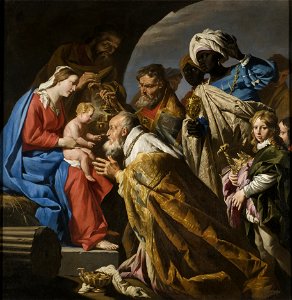As recounted in the gospel of matthew, the three kings journeyed from the east following a star to seek out the king of the jews at bethlehem. Representing different ages, races, and continents – europe, africa, and asia – their homage to christ symbolises the submission of the temporal powers to the authority of the church. Their gifts of gold, frankincense, and myrrh, were interpreted as symbols of the kingship of jesus, his priestly ministry, and his incarnation as a man. The painting gives visual expression to the idea that the new law was founded on the ruins of the old: the space that accommodates the holy family and the retinue of the magi is littered with the broken columns of an ancient temple. A surprisingly bright natural light illuminates the massive figures, modelled by sharp contrasts of light and shade. The magnificent spectacle of the magi and their retinue, their brocade and silk garments rendered with exquisite attention to texture, is tempered by a desire for narrative clarity. By contrast with the realism of the male figures’ physiognomies, a more idealised mode was chosen for the portrayal of jesus and mary. Object Type: painting. Genre: religious art. Date: early 1630s. Dimensions: height: 175 cm (68.8 in); width: 172 cm (67.7 in). Medium: oil on canvas. Depicted People: Christ Child. Collection: Nationalmuseum. The Adoration of the Magi (Matthias Stom) - Nationalmuseum - 18796
Loading...
